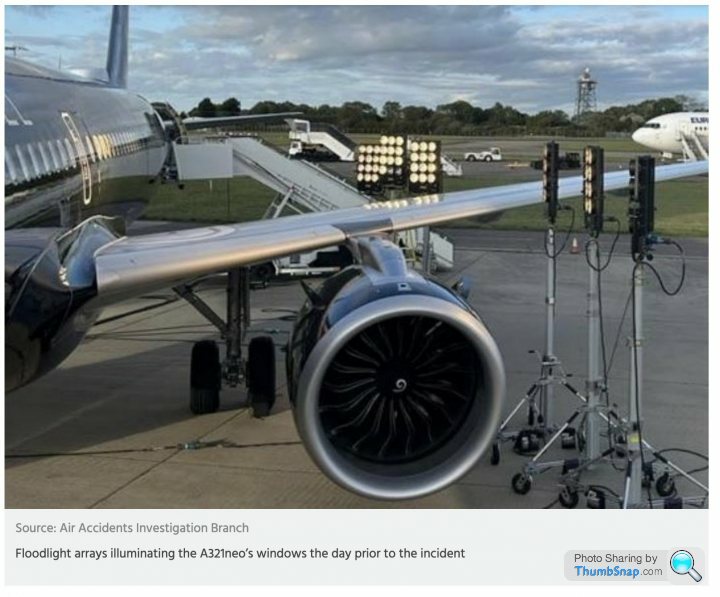Titan A321NEO windows departure cause
Discussion
Simpo Two said:
I would suggest (c) the rubber - or possibly adhesive holding bits together.
NB That window looks designed to blow out; I'd have thought it would be fitted from inside so cabin pressure helps to hold it in place.
I'd not even considered the medium that held them in NB That window looks designed to blow out; I'd have thought it would be fitted from inside so cabin pressure helps to hold it in place.
Edited by Simpo Two on Saturday 11th November 20:13
 - I told you I was a layman LOL.
- I told you I was a layman LOL.Logically I'd have thought the exact same, Pressure holding it in place the same was as it does the doors.Speculating, maybe the heat was responsible for such a level of distortion that it twisted the rubber and adhesive in situ.
Speed 3 said:
MB140 said:
Speed 3 said:
The recent Titan A321NEO incident has a pretty extraordinary cause:

"Investigators believe intense heat from film floodlights concentrated on the exterior of an Airbus A321neo caused the aircraft’s windows to suffer thermal damage, before a number of window panes fell from the jet during a flight from London Stansted."
They should have been placed 10m away from the fuselage but were placed at more like 6m as they were simulating a sunrise for 4 hours filming:

Quite a few holes in that cheese.
Utter b
"Investigators believe intense heat from film floodlights concentrated on the exterior of an Airbus A321neo caused the aircraft’s windows to suffer thermal damage, before a number of window panes fell from the jet during a flight from London Stansted."
They should have been placed 10m away from the fuselage but were placed at more like 6m as they were simulating a sunrise for 4 hours filming:

Quite a few holes in that cheese.
 ks. No way some lamps caused that to happen.
ks. No way some lamps caused that to happen. I remember working Nimrod R1 out of Seeb, went to put power on one lunchtime, thought I would check the internal temperature as I was sweating my arse off within 20 seconds of walking the length of the aircraft and connecting the batteries. The gauges read to 60°C if I remember correctly and were stuck on the stops.
It was over 50°C out on the pan and an aircraft locked up is like a giant oven.
The glass on the outside was that hot you couldn’t touch it we would normally clean the windows on a BF but they were so hot they were getting cleaned the night before on an AF and just left.
No way does a lamp damage a window from that distance away.
While the UK Air Accidents Investigation Branch had already identified exposure to high-temperature lighting – the day before the incident – as the cause of the damage, it reveals that other aircraft have previously encountered a similar issue.
Film lighting was found to have damaged other aircraft including 787s and an A321
Four aircraft received damaged to acrylic cabin windows during filming activities, it states, adding: “In those four cases the damage was identified and repaired before the aircraft flew.”
Six cabin windows were damaged on a Boeing 787 which was filmed inside a hangar and illuminated by three 2,000W lamps positioned on mobile platforms.
The windows suffered “significant deformation”, says the Air Accidents Investigation Branch, with one of them having a hole burned through its panes.
Boeing referred to three occurrences of 787 windows sustaining thermal damage in its customer safety publication, recommending that operators avoiding high-intensity lights during film work – or at least keep them distant from the cabin and use equipment which minimises infra-red emission.
Source: via Air Accidents Investigation Branch
Damage to windows in previous occurrences had been noticed before the aircraft flew
The inquiry mentions another mishap involving an A321 after spotlights were placed just inboard of the engines – about 1.5-1.8m from the windows – during an outdoor filming exercise.
“When the damage was reported to Airbus, it was not aware of any other occurrences, and considered the circumstances to be outside the anticipated operating conditions,” it states.
Six UK operators responded to an Air Accidents Investigation Branch query about safety management for filming.
“Most operators emphasised the importance of engineering supervision for the activity,” it says.
“One operator had identified the risk of heat from external lighting damaging a composite fuselage but none of the operators had previously identified the risk of heat damaging aircraft windows, except for an operator that had previously suffered damage from this cause.”

Gassing Station | Boats, Planes & Trains | Top of Page | What's New | My Stuff




